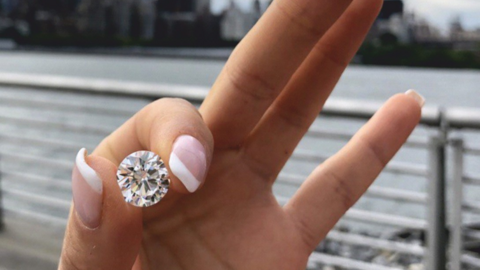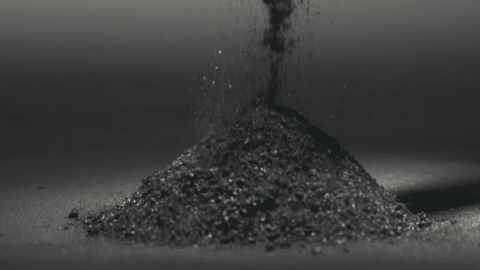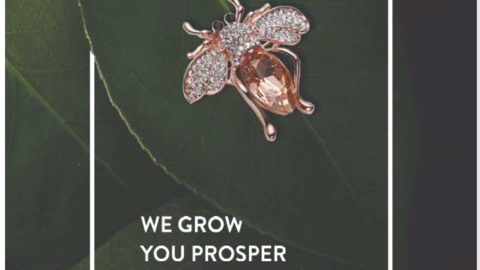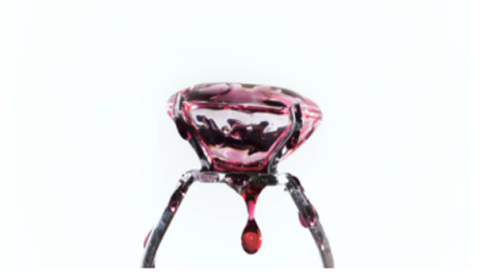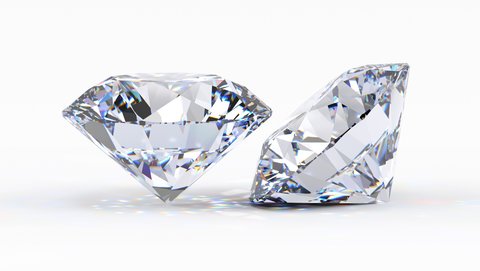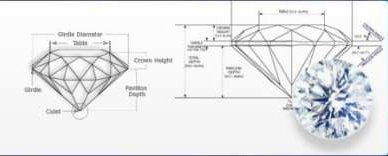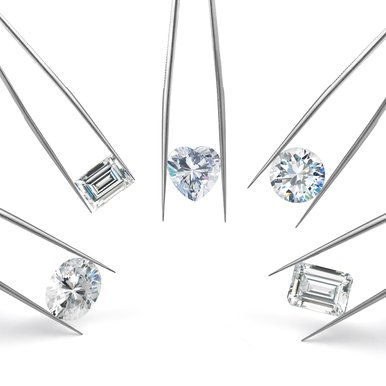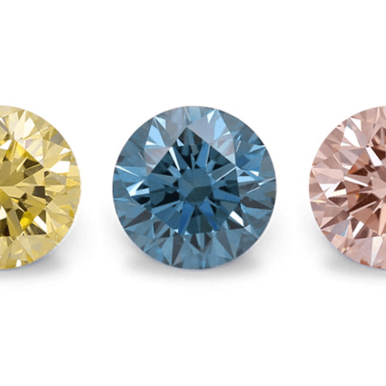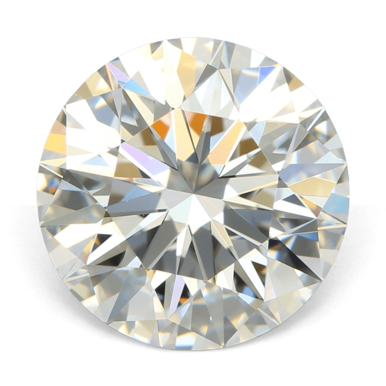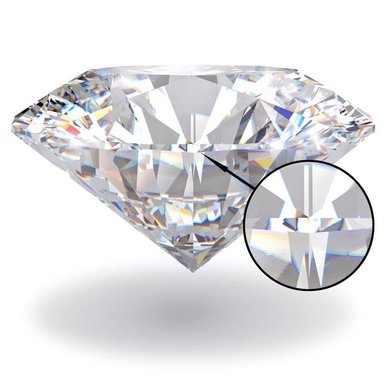Rose Cut Lab Grown Diamonds: The Timeless Elegance of Modern Lab-Grown Creations
Rose Cut Lab Grown Diamonds
In today's jewelry landscape, rose cut diamonds are experiencing a remarkable renaissance. These distinctive gems, characterized by their flat bottoms and faceted domed tops, offer a vintage charm that perfectly complements contemporary designs. As modern consumers seek unique alternatives to traditional brilliant cuts, rose cut diamonds have emerged as a captivating option that combines historical elegance with understated sophistication.
At Labrilliante, we've witnessed growing demand for these exquisite stones, particularly in lab-grown varieties that offer ethical sourcing alongside the timeless beauty of this classic cut. Whether you're drawn to their subtle glow, their connection to jewelry history, or their distinctive silhouette, rose cut diamonds provide a refreshing alternative for those seeking jewelry with character and meaning.

What is a Rose Cut Diamond?
A rose cut diamond is characterized by its unique structure featuring a flat bottom and a domed top with triangular facets that create a shape reminiscent of an opening rose bud. Unlike modern brilliant cuts with 57-58 facets, rose cut diamonds typically contain between 3 and 24 triangular facets that rise to a single apex, though variations exist.
What truly sets rose cut diamonds apart is their distinctive light performance. While brilliant cuts are designed to maximize sparkle through light return, rose cut diamonds offer a more subtle, romantic glow with gentle flashes of light. This soft luminescence creates an understated elegance that many find appealing for its vintage character and gentle presence.
At Labrilliante, our lab-grown rose cut diamonds maintain all the visual characteristics of their natural counterparts while offering enhanced ethical and environmental benefits. The flat base and faceted dome create a distinctive silhouette that stands apart from more common diamond cuts, making them perfect for those seeking jewelry with unique character.
History and Origin
Rose cut diamonds date back to the 16th century, making them one of the earliest diamond cutting styles in jewelry history. They reached the height of their popularity during the Georgian (1714-1837) and Victorian (1837-1901) eras when diamond cutting technology was still developing and cutters sought to maximize the visual appeal of rough stones while minimizing material loss.
These diamonds adorned the jewelry of European royalty and aristocracy, featuring prominently in elaborate brooches, necklaces, and rings of the period. Their low profile made them ideal for the delicate, intricate metalwork characteristic of these historical eras. By the late 19th century, with the advent of modern cutting techniques and the discovery of diamond mines in South Africa, brilliant cuts began to overshadow rose cuts in popularity.
Today, Labrilliante is proud to be at the forefront of the rose cut renaissance, creating lab-grown diamonds that honor this rich historical tradition while incorporating modern ethical standards. The current resurgence in popularity reflects a growing appreciation for vintage aesthetics combined with contemporary values of sustainability and responsible sourcing.

How Rose Cut Diamonds Are Made
The creation of rose cut diamonds combines traditional craftsmanship with modern technology, particularly in the lab-grown diamond sector where Labrilliante specializes. Unlike mass-produced brilliant cuts, each rose cut diamond maintains a unique character due to the individualized cutting process.
For traditional rose cuts, skilled cutters begin with a rough diamond and carefully map out the placement of facets. The process requires exceptional precision as each triangular facet must align perfectly to create the characteristic rose-like appearance. Modern cutters often use specialized tools while still maintaining the handcrafted essence that makes each stone unique.
At Labrilliante, our lab-grown rose cut diamonds are created using advanced technology that precisely controls the diamond growth process, followed by expert cutting. This approach allows for greater consistency in quality while still preserving the distinctive character of each stone. The resulting diamonds can be crafted in various shapes beyond the traditional round—including oval, pear, cushion, and hexagonal variations—offering versatility for diverse jewelry designs.
Key Features and Characteristics
Rose cut diamonds possess several distinctive features that set them apart from other diamond cuts, making them a unique choice for discerning jewelry enthusiasts.
Distinctive Structure
The most defining characteristic of a rose cut diamond is its architectural design. With a flat base and a domed crown composed of triangular facets that meet at a central point, these diamonds resemble an opening rosebud—hence their romantic name. This structure creates a gem that sits lower than brilliant cuts and maintains a distinctive visual profile.
Exceptional Face-Up Appearance
One of the most remarkable advantages of rose cut diamonds is their impressive face-up appearance. At Labrilliante, our clients are often surprised to discover that rose cuts appear approximately 15-20% larger than brilliant cut diamonds of identical carat weight. This is due to the flat bottom and shallow depth, which concentrates the diamond's weight across its visible surface area rather than in its depth.
Low-Profile Comfort
The minimal height of rose cut diamonds makes them exceptionally comfortable for everyday wear. They sit close to the skin and are less likely to catch on clothing or objects, making them ideal for engagement rings and daily-wear jewelry pieces that need to withstand active lifestyles.
Unique Light Performance
Rather than the intense sparkle of brilliant cuts, rose cut diamonds produce a subtle, internal glow with gentle flashes of light. This distinctive light performance creates a soft, romantic radiance that many find appealing, particularly in candlelight or softer lighting environments.
Key Features and Characteristics of Rose Cut Diamonds
| Feature | Rose Cut Diamond |
|---|---|
| Base | Flat, no pavilion |
| Crown | Domed with triangular facets |
| Facet Count | 3-24 facets |
| Profile | Low, sits close to skin |
| Light Performance | Subtle glow, gentle flashes |
| Face-Up Size | Appears 15-20% larger than same-carat brilliant cuts |
| Ideal Settings | Bezel, halo, vintage-inspired designs |
The 4Cs of Rose Cut Diamonds
When evaluating any diamond, the 4Cs—cut, color, clarity, and carat—provide essential metrics for assessment. However, these characteristics take on unique considerations when applied to rose cut diamonds.
Cut
The cut of a rose cut diamond is its most distinctive feature. Unlike standardized brilliant cuts, each rose cut is uniquely handcrafted. At Labrilliante, our master cutters carefully position each facet to create optimal light play within the constraints of this historical cut. While traditional rose cuts feature 3-24 facets, modern variations may include additional facets for enhanced visual appeal. The quality of the cut is assessed by symmetry, proportion, and the precision of facet alignment rather than by standardized cut grades used for brilliant diamonds.
Color
Rose cut diamonds are remarkably forgiving when it comes to color. Their unique faceting pattern tends to mask slight color tints, making them excellent candidates for warmer color grades. While completely colorless rose cuts (D-F color) create a pristine appearance, many Labrilliante clients intentionally select warmer tones (G-J) for their vintage appeal. Rose cuts also excel in fancy colored diamond varieties, where their faceting enhances natural color saturation rather than diminishing it.
Clarity
Due to their large, open facets, inclusions are more visible in rose cut diamonds than in brilliant cuts. At Labrilliante, we recommend VS2 clarity or higher for most rose cut diamonds to ensure eye-clean appearance. However, for those seeking character, "salt and pepper" rose cuts with visible natural inclusions have become increasingly popular for their unique, organic aesthetic. These inclusions create one-of-a-kind patterns that many find appealing for their individual character.
Carat
Perhaps the most appealing aspect of rose cut diamonds is their impressive face-up appearance relative to their carat weight. A 1-carat rose cut diamond can appear similar in size to a 1.2-carat brilliant cut, offering excellent value. At Labrilliante, we find that most clients select rose cut diamonds between 0.75 and 2.5 carats for engagement rings, though their versatility makes them suitable for virtually any size preference.
The 4Cs of Rose Cut Diamonds
| 4Cs Factor | Rose Cut Considerations | Labrilliante Recommendations |
|---|---|---|
| Cut | Hand-crafted, 3-24 facets, no standardized grades | Prioritize symmetry and proportion |
| Color | Forgiving of warmer tones, enhances fancy colors | D-F for modern looks, G-J for vintage appeal |
| Clarity | Inclusions more visible, "salt & pepper" options popular | VS2+ for traditional aesthetics, included stones for character |
| Carat | Appears 15-20% larger than brilliant cuts | 0.75-2.5ct for engagement rings, all sizes available |
Lab-Grown vs. Natural Rose Cut Diamonds
The choice between lab-grown and natural rose cut diamonds represents one of the most significant decisions for today's conscious jewelry consumers. At Labrilliante, we specialize in lab-grown rose cut diamonds that offer remarkable benefits while maintaining the same visual characteristics and physical properties as their mined counterparts.
Identical Physical Properties
Lab-grown rose cut diamonds are physically, chemically, and optically identical to natural diamonds. They possess the same carbon crystal structure, hardness, and light performance. Even professional gemologists require specialized equipment to distinguish between them. The difference lies solely in their origin—one formed deep within the earth, the other created in controlled laboratory conditions.
Price Advantage
One of the most compelling benefits of choosing a lab-grown rose cut diamond is the significant cost savings. At Labrilliante, our lab-grown rose cuts typically cost 30-40% less than mined diamonds of comparable quality and size. This price difference allows customers to select larger stones, higher quality grades, or more elaborate settings while remaining within their budget.
Ethical Considerations
Many of our clients choose lab-grown rose cut diamonds for their transparent origin and minimal environmental impact. Each Labrilliante diamond comes with complete transparency regarding its creation process, offering peace of mind unavailable with many mined diamonds. This ethical clarity has made lab-grown rose cuts particularly popular among environmentally and socially conscious consumers.
Lab-Grown vs. Natural Rose Cut Diamonds
| Factor | Lab-Grown Rose Cut Diamonds | Natural Rose Cut Diamonds |
|---|---|---|
| Composition | Carbon crystal structure | Carbon crystal structure |
| Physical Properties | Identical hardness, brilliance | Identical hardness, brilliance |
| Price | 30-40% lower for same quality | Higher premium |
| Origin Traceability | Complete transparency | Often limited transparency |
| Environmental Impact | Minimal land disruption | Varies by mining operation |
| Availability | Increasingly accessible | Rarer, especially in antique cuts |
Pros and Cons
When considering a rose cut diamond, it's important to weigh the unique advantages and potential limitations of this distinctive cut to determine if it aligns with your preferences and lifestyle.
Pros
Unique Vintage Aesthetic: Rose cut diamonds offer a distinct look that stands out from the more common brilliant cuts. At Labrilliante, we find that clients who choose rose cuts are often drawn to their historical charm and subtle elegance.
Impressive Size Appearance: Due to their flat base and larger surface area, rose cut diamonds appear significantly larger than brilliant cuts of the same carat weight, providing excellent value.
Versatility in Design: The low profile and distinctive character of rose cuts work beautifully in various settings, from antique-inspired designs to clean, contemporary styles.
Comfort for Daily Wear: The minimal height and smooth dome make rose cut diamonds exceptionally comfortable for everyday wear, with less likelihood of snagging on clothing.
Rare and Distinctive: Choosing a rose cut diamond ensures your jewelry stands apart from more common diamond cuts, creating a conversation piece with historical significance.
Cons
Less Brilliance: Rose cut diamonds offer a subtle glow rather than the intense sparkle of brilliant cuts. While many appreciate this distinctive light performance, those seeking maximum fire and brilliance may prefer more modern cuts.
More Visible Inclusions: The larger, open facets can make inclusions more noticeable, potentially requiring higher clarity grades for a clean appearance.
Specialized Knowledge Required: Finding jewelers with expertise in rose cut diamonds can be challenging, though Labrilliante specializes in this unique cut.
Pros and Cons of Rose Cut Diamonds
| Pros | Cons |
|---|---|
| Unique vintage aesthetic | Less brilliance than modern cuts |
| Appears larger for the same carat | Inclusions more visible |
| Comfortable, low-profile design | Specialized knowledge required |
| Works in diverse setting styles | Fewer setting options in mass-market jewelry |
| Distinctive conversation piece | Not as widely available as brilliant cuts |
Rose Cut vs. Brilliant Cut Diamonds
Understanding the differences between rose cut and brilliant cut diamonds helps in making an informed choice that aligns with your personal style preferences and practical considerations.
Structural Differences
Rose cut diamonds feature a flat base with a domed top covered in triangular facets, typically ranging from 3 to 24 facets. In contrast, modern brilliant cut diamonds contain 57-58 facets arranged in a specific pattern with both a crown (top) and pavilion (bottom). This fundamental difference in structure influences every aspect of the diamond's appearance and performance.
Light Performance
The most noticeable difference between these cuts lies in how they interact with light. Brilliant cuts are engineered to maximize light return through precise internal reflection, creating the intense sparkle that many associate with diamonds. Rose cuts, developed centuries before modern optical science, produce a softer, more subtle glow with gentle flashes rather than fiery brilliance. At Labrilliante, we often describe this difference as "candlelight versus spotlight"—each beautiful in its unique way.
Visual Size and Presence
Due to their flat base and weight distribution, rose cut diamonds typically appear 15-20% larger than brilliant cuts of the same carat weight. This larger face-up appearance provides exceptional value, particularly important when selecting lab-grown diamonds where sustainability meets affordability.
Setting Considerations
The low-profile nature of rose cut diamonds allows for distinctive setting possibilities. They sit closer to the finger, making them ideal for flush settings, bezel surrounds, and intricate vintage-inspired designs. Brilliant cuts, with their higher crowns, often require prong settings to showcase their light performance properly.
Rose Cut vs. Brilliant Cut Diamonds
| Feature | Rose Cut | Brilliant Cut |
|---|---|---|
| Origin | 16th century | Early 20th century |
| Facet Count | 3-24 triangular facets | 57-58 precisely arranged facets |
| Base | Flat | Pointed pavilion |
| Profile | Low, sits close to skin | Higher profile |
| Light Performance | Subtle glow, gentle flashes | Intense sparkle, fire and brilliance |
| Face-Up Size | Larger appearance for same carat | Smaller face-up appearance |
| Ideal Settings | Bezel, halo, vintage designs | Prong, cathedral, solitaire |
| Best For | Vintage aesthetic, comfort, unique character | Maximum sparkle, traditional look |

Popular Shapes and Styles
Rose cut diamonds offer exceptional versatility in shapes, allowing for unique expressions of personal style while maintaining their characteristic low profile and gentle luminescence.
Classic Round Rose Cuts
The round rose cut is the most traditional shape, dating back to the original 16th-century designs. At Labrilliante, our round rose cuts feature perfect symmetry with facets that radiate from a central point, creating a balanced and timeless appearance. This classic shape works beautifully in solitaire settings, vintage-inspired halos, and three-stone designs.
Elongated Variations
Oval and pear-shaped rose cuts have gained significant popularity for their elegant, elongating effect when worn. These shapes maximize the face-up appearance advantage of rose cuts, creating dramatic visual impact. Labrilliante's oval rose cuts offer approximately 10% larger face-up appearance than round rose cuts of equivalent carat weight.
Geometric Options
For those seeking contemporary interpretations of this historical cut, hexagonal, kite-shaped, and shield-shaped rose cuts offer distinctive geometric silhouettes. These angular variations pair exceptionally well with modern, minimalist settings and appeal to those with avant-garde tastes.
Fancy Shapes
Cushion, marquise, and trillion rose cuts combine historical cutting techniques with fancy shape outlines, offering truly unique options. These shapes are particularly popular in Labrilliante's bespoke engagement ring designs, where clients seek one-of-a-kind expressions of their personal style.
Buying Guide: What to Look For
When purchasing a rose cut diamond, several specific considerations will help ensure you select the perfect stone for your needs and preferences.
Clarity Considerations
Due to the open facet structure of rose cut diamonds, clarity becomes particularly important. At Labrilliante, we recommend VS2 clarity or higher for most rose cut diamonds to ensure an eye-clean appearance. However, if you're drawn to the character of included diamonds, consider a "salt and pepper" rose cut, where natural inclusions create unique patterns that add personality to your stone.
Color Selection
Rose cuts are more forgiving of color than brilliant cuts, making them excellent candidates for warmer diamond colors. For a traditional look, consider G-H color grades which offer excellent value while maintaining a nearly colorless appearance. For those seeking vintage appeal, I-J colors can impart a subtle warmth that enhances antique-inspired settings.
Shape and Proportions
When evaluating a rose cut diamond, look for symmetrical facets and balanced proportions. The dome should rise gracefully from the flat base, with facets meeting precisely at the apex. At Labrilliante, we ensure each rose cut demonstrates exceptional craftsmanship with even faceting and ideal proportions.
Setting Compatibility
Consider how your rose cut diamond will be set to maximize its unique beauty. Bezel settings provide secure protection for the edges while highlighting the diamond's distinctive silhouette. Halo settings amplify the already impressive face-up appearance, while vintage-inspired settings with milgrain details and filigree complement the historical nature of the cut.
Where to Purchase
When seeking high-quality lab-grown rose cut diamonds, look for specialized retailers with expertise in fancy cuts. Labrilliante offers an extensive selection of certified lab-grown rose cut diamonds in various shapes, colors, and clarity grades, along with custom design services to create the perfect setting for your unique stone.
Care and Maintenance
Proper care ensures your rose cut diamond maintains its subtle beauty for generations to come. While diamonds are the hardest natural substance, they still require appropriate maintenance.
For daily cleaning, gently wipe your Labrilliante rose cut diamond jewelry with a soft, lint-free cloth to remove oils and maintain its luminous glow. For deeper cleaning, soak the piece in warm water with mild dish soap for 20-30 minutes, then gently brush with a soft toothbrush, paying special attention to the underside where the flat base may collect residue.
Store your rose cut diamond jewelry separately from other pieces to prevent scratching, ideally in a fabric-lined box or pouch. Though the low profile of rose cuts makes them less prone to damage than higher-profile cuts, we recommend removing your jewelry during high-impact activities or when using harsh chemicals.
FAQ Rose Cut Lab Grown Diamonds
Actually, brilliant cut diamonds are typically 20-30% less expensive than rose cut diamonds of the same carat weight. This is due to the higher level of experise and greater volume of rough diamond material required to receive the excellently-cut rose diamond. At Labrilliante, our lab-grown rose cuts offer even greater value, combining the price advantage of both the cut style and laboratory creation.
Absolutely! Rose cut diamonds make excellent engagement ring centerpieces. Their low profile sits comfortably on the finger for everyday wear, while their unique appearance and vintage charm create a distinctive alternative to traditional brilliant cut diamonds.
Clean rose cut diamonds by soaking them in warm water with mild dish soap for 20-30 minutes, then gently brushing with a soft toothbrush. The flat bottom of rose cuts can collect residue, so pay special attention to cleaning underneath the stone.
Yes! The "salt and pepper" trend embraces visible inclusions in rose cut diamonds as unique patterns that add character. At Labrilliante, we select included rose cuts where the inclusions create aesthetically pleasing patterns, transforming what might be considered flaws into distinctive design elements.
Rose cuts are remarkably versatile! Warmer-toned rose cuts (I-J color) pair beautifully with yellow or rose gold for a vintage aesthetic, while colorless rose cuts (D-F) create a striking contrast against yellow gold or appear seamlessly integrated in white gold or platinum settings.
Traditional antique rose cuts often have irregular outlines reflecting hand-cutting techniques of their era. At Labrilliante, we offer both precisely symmetrical rose cuts for modern tastes and "old world" cuts with subtle irregularities that capture the authentic character of historical diamonds.
No, lab-grown rose cut diamonds will not change color over time. They possess the same chemical stability as natural diamonds, ensuring they maintain their appearance indefinitely. The crystalline carbon structure of both lab-grown and natural diamonds is extremely stable.
Several celebrities have helped popularize rose cut diamonds. Jennifer Aniston's engagement ring featured a substantial rose cut diamond, while Alicia Keys wears an antique cushion rose cut. These high-profile examples have contributed to the rising interest in this historical cut for modern engagement rings.


